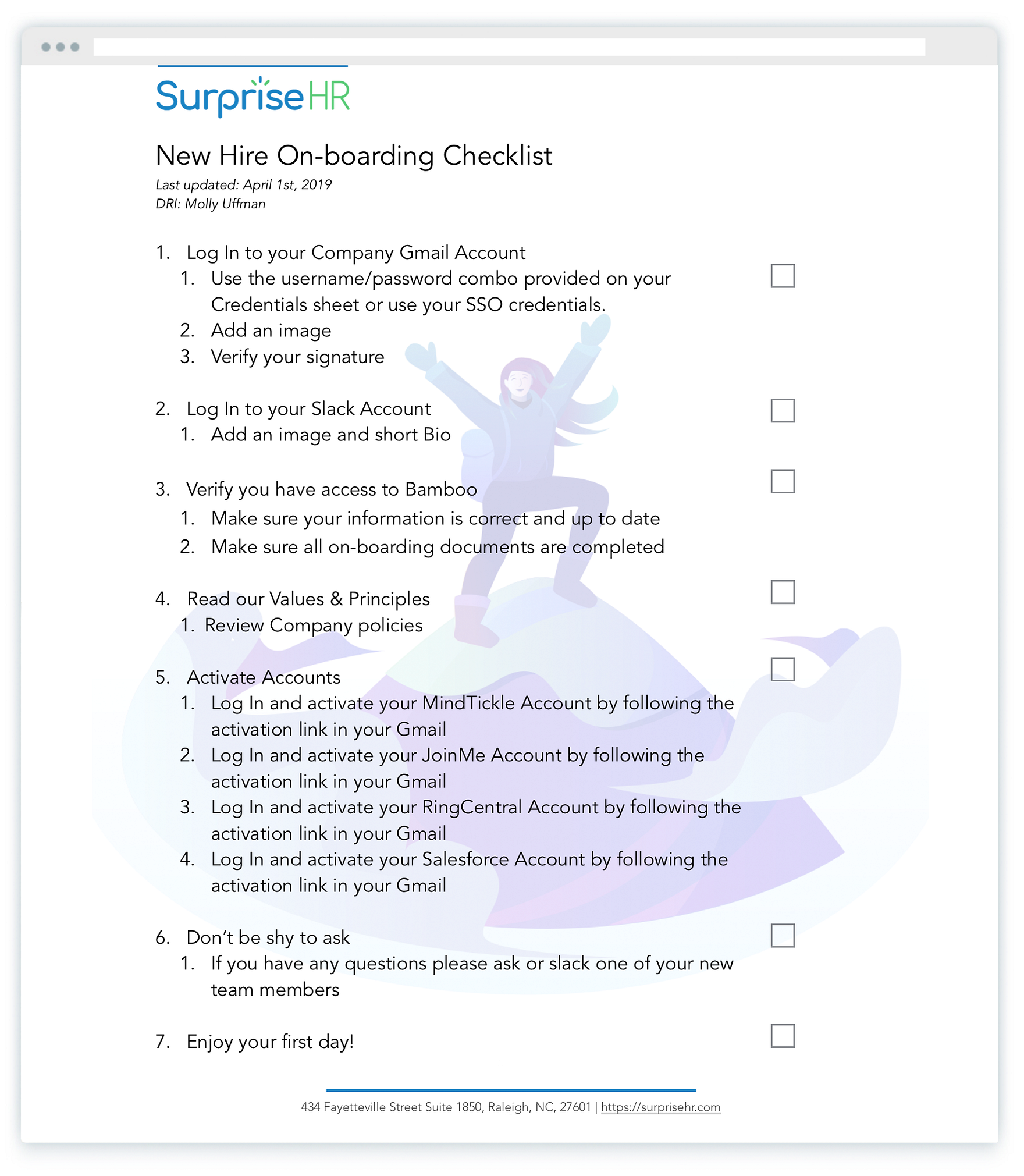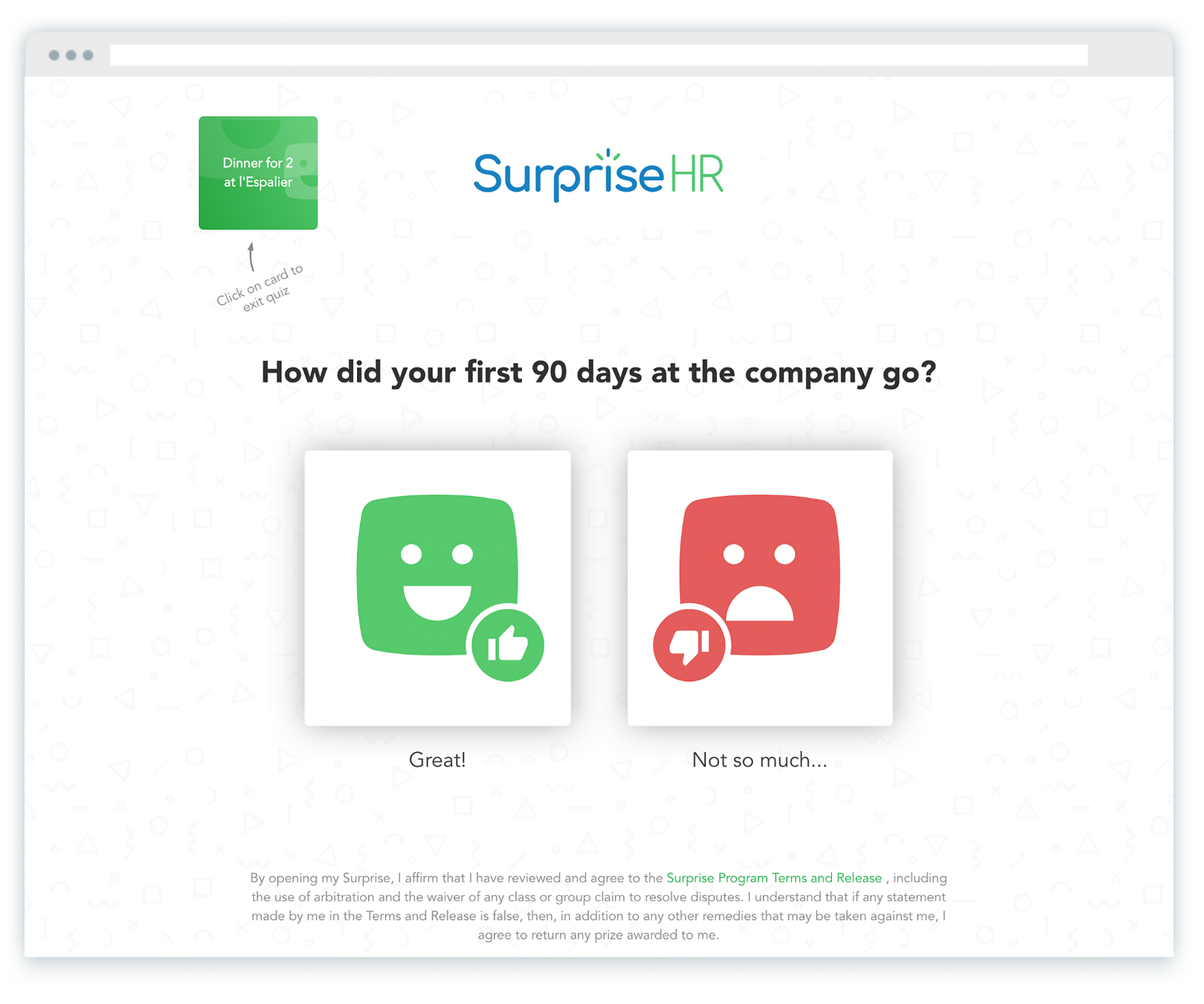Your Employees Start Out So Excited. Why Doesn’t It Last?

This post originally appeared at https://surprisehr.com/blog.
What went wrong? What does it take for companies to keep that first-day glow from fading?
Especially for upper-level or specialized positions, the expense of employee turnover is astronomical. Investing all of that time and effort to recruit and train an employee only to do it all over again in four, six, or even twelve months is frustrating and costly.
If you’re hiring a new employee and you want to get it right the first go-round, here are 4 tips on where you need to start.
Stage 1: Start Day Countdown

A) Never Extend an Offer and Then Go Silent
Being new is nerve wracking. It’s worse when you don’t know what to expect, so your goal is to eliminate as many of the unknowns as possible.
Where do I park? How early do I show up? What should I bring? These questions weigh on new hires. After an offer is accepted, stay in touch and provide exactly this type of information so they know what to expect on their first day. You can create and share an FAQ list with the most common questions, as long as you don’t skip out on giving them personal attention.
B) Wrap Up the Paperwork Early
This is the perfect time for new hires to complete all of that required (ahem, boring) paperwork. It’s easily done in advance, and then, when they’re in the office, they can focus on things that are more productive — and interesting. Our team loves using PandaDoc, but there are tons of options to choose from for sending, managing, and e-signing documents.
C) Win Them Over with Swag
Surprise your new team member with an amazing welcome package. Giving them your favorite company swag along with some just-for-fun gifts (some healthy treats are always a good go-to) will make them immediately feel part of the family. And, really who doesn’t love free stuff??
This is also an excellent opportunity to share books that will help employees either learn about your culture or become rockstars at their jobs. For example, our company gives every new employee Ray Dalio’s Principles and Annie Duke’s Thinking in Bets. (If you haven’t read these before, we can’t recommend them enough!)

Mail your welcome package before employees start or have it waiting on their desk on the first day. Either way, we promise that this surprise will get them even more amped to be on board.
D) Set Their Space Up So They Can Hit the Ground Running
Sitting around with no computer and nothing to do is the worst. Your employee’s desk and office equipment should be 100% ready. This means software is installed. Email is working. A nameplate is up. Business cards are provided. Maybe they even have meetings already on the calendar. And don’t forget to put out their welcome swag if they didn’t already receive it!

E) Jumpstart the Introductions
Right before the big day, email your team to remind them that your new hire is starting. Describe what responsibilities they’ll have along with their skills and strengths. Throw in a few personal details for conversation starters too — hobbies, a favorite sports team, city of origin, etc. (Obviously, you’ll need to gather these fun facts in advance.) CC your new hire so they know the message went out and so everyone has each other’s contact info.
Stage 2: A New Beginning
A) Start the Day Right
Your new employee should feel welcome from the moment they arrive. Plan for a friendly face to greet them and show them to wherever they need to be. Then, give them a schedule for the rest of the day and a new hire checklist so they can track what they need to do and when to do it. (And don’t forget to plan for an end-of-day check-in where you ask how Day 1 went and what you can do to make Day 2 smoother.)
B) Introduce the Team
Help new employees figure out who to ask for what by sharing an org chart or staff directory they can reference anytime. It’s a simple thing that can make their work life so much easier.
You should also start arranging meetings with people they’ll need to know. During introductions, hype your new hire’s knowledge and expertise. This boosts your employee’s confidence and helps others understand what their new coworker does and how they’ll work together in the future. For more informal conversations, plan a team lunch on the first day and a happy hour at the end of the week to bring the group together.

C) Align Expectations
Meet with your hire to get on the same page about their responsibilities and your expectations. Be open and direct in your conversation. At the same time, make sure they’re seeing the big picture: your company values, goals, and how their work ties into it all. And whatever your leadership and business philosophies are, be upfront. New employees need your honesty and authenticity to know where to focus their time.
D) Assign Bite-Sized Tasks
There’s no need to throw them in the deep end on their first week. Start with clearly defined tasks that ramp up in complexity over time. Whatever assignments you choose, prepare the details needed in advance, so that even if you have a crazy day (we get it, emergencies happen), your new employee has enough information to get to work and stay busy.
Stage 3: Strengthening the Relationship
A) Create a Roadmap for the First 90 Days
To keep the good times going, your employees need something definitive to work toward. During their first week, get together to set goals for their first 30, 60, and 90 days and a plan for how to achieve them. This plan won’t work if you create it on your own; it has to be a collaboration between you and your employee.
B) Give Them What They Need to Perform
Once you’ve agreed on a plan, please don’t set them up to fail. Of course, you’d never do that on purpose, but inadvertently…it happens. Instead, connect them with the tools and support they need. For example, having a central knowledge base is super helpful for everyone. For us, we recently switched to Confluence and we’ve already seen increased information sharing and productivity across teams.
Another tip is to give new employees a mentor or office buddy who can show them the ropes and answer day-to-day questions, no matter how small. So many questions come up when you start a new job — about office norms, project workflows, software, you name it — and it’s nice to know you have a place to turn for help and advice.
C) Check-In and Provide Feedback
Schedule (and show up for) recurring check-ins with your new hire. Weekly is often best at first, but you may not always need to meet so frequently. Have your employee prepare a short list of items to cover each week, and you do the same. Plan time in your agenda to discuss those lists and agree on next steps to address any issues. Leave a few minutes for any additional concerns or questions that come up, and end by thanking them for their efforts so far.

D) Use Performance Reviews to Inspire Ongoing Growth
Part of the reason for meeting regularly is that employees should always know where they stand, so that formal evaluations don’t contain any surprises. In your 1:1s, you should be discussing their progress, how they measure up to expectations, and how they can better manage roadblocks in their way. Then, at 90 days, you can review how far they’ve come — a practice you can continue with quarterly or bi-annual reviews from then on.
Before a formal review, have your employee get the ball rolling with a self evaluation. To help employees understand how others view their work, you can also gather 360° feedback. Then, in the review meeting, go over what’s working well, what to change, and what new things to start doing. Inspire your employee to keep progressing by documenting past achievements and setting new goals for the future. Your employee should leave this review with a big picture understanding of how they’ve done so far, and what they need to do now.
Stage 4: Celebrating Progress
As your employees hit milestones and achieve their 30–60–90 goals (and beyond), take the time to recognize this. When they exemplify company values, reinforce their behavior by acknowledging and celebrating it in a new way each time. When they mess up, be understanding. Making a mistake is fine; it’s a teaching moment. Learning should be what you value, and you can communicate that to your employees by celebrating their improvement and growth.
Remember, onboarding is a complex process involving many people and parts, and it can take anywhere from six months to one year. When you do it right, you can help your employees maximize their potential and blow their initial goals out of the water — which is exactly what they wanted to do from the beginning.
When it comes to keeping them focused on and continuing that goal-directed behavior, research shows that intermittent rewards are key, whether it’s in an employee’s first year or their tenth. Keep doing the same thing or providing the same reward and employees adapt. What was once exciting becomes the new standard, so maintaining that early enthusiasm and work ethic means you’ve got to mix it up.




Comments (0)